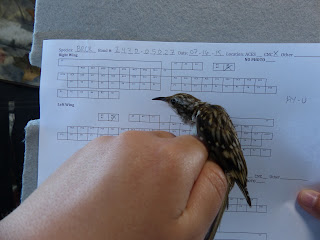As our internship is nearing an end, Krista and I have begun analyzing photographs and data to turn our summer's work into lasting research. Short-term we have been refining photography techniques so that our photos of wings, tails and individual feathers are clear and useful down the line.
Long-term we are looking at improving aging techniques in wood thrush. The current guidelines seem inconsistent to Bishop, so we will be looking for patterns in the changes of wing feathers as the birds age.
For most every bird we catch, we take a "mugshot,"
 |
| Field sparrow |
 |
| Brown creeper |
 |
| Rose-breasted grosbeak male |
pictures of both wings,
 |
| Wood thrush p10 |
Our first step toward new aging techniques in the wood thrush will be looking at the lighter, buffy tips in the primary and lesser coverts to establish a scale of the color and shape range. If we see consistent patterns in the tips (such as shrinking in size and fading in color) between hatching year, second year and after second year birds, we could develop a better idea of how to determine the age of wood thrush.
 |
| Wood thrush wing |
If we succeed, the data that Bishop collects on the birds will become more accurate and better contribute to future bird research and bird demographics.
















No comments:
Post a Comment